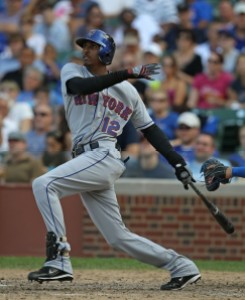 Just think if the Texas Rangers had Robinson Cano in their already-loaded lineup. It could have happened.
Just think if the Texas Rangers had Robinson Cano in their already-loaded lineup. It could have happened.
Back in the winter of 2003 the Rangers had a choice between Cano and another young infielder, Joaquin Arias, as the player to be named with Alfonso Soriano for Alex Rodriguez.
The Rangers chose Arias and “Now you know the rest of the story,” as Paul Harvey would say.
At the time Arias was an 18-year-old shortstop from the Dominican Republic who had posted a .266/.306/.362 line with 3 homers and 12 stolen bases in 481 at-bats at low Class A Battle Creek in the Midwest League. Cano, then 20, had split the 2003 campaign between Class AA and A, batting .277/.322/.374 with six homers and one stolen base in 530 at-bats.
Since that fateful day, Arias hasn’t been able to stick at the major league level and now finds himself in New York with the Mets while Cano has turned into one of the best hitters in the game and an MVP candidate.
This story serves as another reminder of what an inexact science scouting is. Not only did Texas take Arias instead of Cano, the acquisition convinced them to pass on Stephen Drew in the 2004 draft and take right-hander Thomas Diamond instead. Diamond had an impressive start to his career but blew out his arm, left the organization as a free agent last season, signed with the Cubs and pitched 16 major league games in 2010.
Statistically speaking, there wasn’t much difference between Arias and Cano back in ’03. Both hit for a solid average playing against much more experienced players, showed little power, rarely walked and struck out infrequently.
Texas considered Arias the more exceptional athlete. He had great range in the field and a strong throwing arm, and the Rangers felt he’d be a solid hitter with decent power. He also was more of a base-stealing threat. So they made their decision.
Cano broke in as an everyday starter in 2005 and has hit .309/.347/.489 in six years. He had career highs of 29 homers, 109 RBI and 57 walks this season while reaching 200 hits and 100 runs for the second straight season.
Meanwhile, Arias posted two separate seasons of .300 while steadily moving through the levels in the Texas organization. He made his September debut with the big club in 2006. He was injured most of the 2007 campaign and played 157 games at the major league level over the next three years, becoming mainly a utility infielder.
His reign in Texas ended when the Rangers acquired Cristian Guzman from Washington to fill in for injured starting second baseman Ian Kinsler down the stretch. Texas shipped Arias to New York for Jeff Francoeur in late August.
Arias batted .200 in 30 at-bats for New York and he’s a. 276/.314/.362 hitter in 275 major league plate appearances in parts of four seasons.
Can Arias help the Mets in 2011?
Since the Mets already have second basemen Ruben Tejada and Luis Castillo onboard, it seems unlikely Arias provides any contribution other than as a utility player. He has pretty much the same skill set as Tejada, who is six years his junior and a better defender.
It’s obvious the now 26-year-old Arias hasn’t fulfilled expectations and has reached an age where he’s maxed out his potential. The right-handed hitter hasn’t developed the pop expected and his 10-15 stolen base potential is far outweighed by his extremely poor walk rate. Defensively, he hasn’t shown the ability to play consistent defense and his defensive metrics aren’t anything to get excited about.
So there’s no chance the Mets will stumble into a Robinson Cano. In fact, they won’t even get a Roger Cedeno.

If the Mets dump Castillo in the off-season, is Arias a potential backup middle infielder?
I don’t think Arias would even be the Mets first choice for utility infielder should Castillo depart. They would probably try and find a more seasoned player.
I think New York took Arias to see if he had any of that promise left.